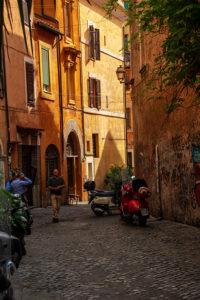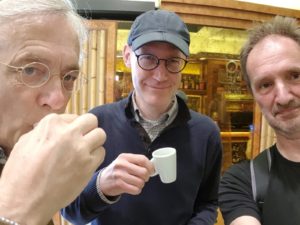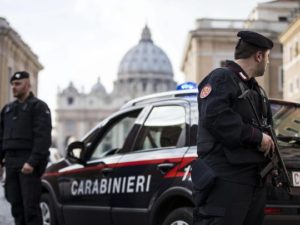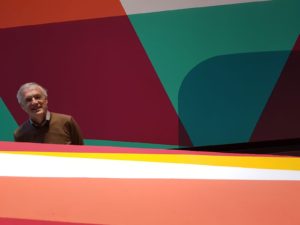
 On our annual trip to an interesting city, with our group of three ‘Placemaking experts’ enjoying live geography…, we visited Rome this year — the city where I once lived for a bit more than a year –, to get an impression of newest developments of ‘overtourism’ and ‘urban development’, but of course also to get a real ‘feeling’ of the city and of the typical Roman atmosphere, as expressed by a real Italian coffee, unbeatable in quality, speed in processing, and… in price.
On our annual trip to an interesting city, with our group of three ‘Placemaking experts’ enjoying live geography…, we visited Rome this year — the city where I once lived for a bit more than a year –, to get an impression of newest developments of ‘overtourism’ and ‘urban development’, but of course also to get a real ‘feeling’ of the city and of the typical Roman atmosphere, as expressed by a real Italian coffee, unbeatable in quality, speed in processing, and… in price.
 Interesting enough all the highlights of Rome are nowadays highly securitised, because of terrorist threats. So if you go to a church to participate in the holy mess, you might need to pass heavily armed security personnel and have your day-packs checked. This is supposed to provide a feeling of safety, a rather ambivalent feeling in such a setting, and a topic for further research on Placemaking as our colleague Prof. Ben Anderson in his article on ‘Boredom, excitement and other security affects‘ from 2015 expresses. At the same time visitors do not seem to bother and except and undergo it as if it is everyday normality. However a personal experience I had many years ago in Münster, Germany proves that there are different normalities. Münster is a city of cyclists, like also many Dutch cities, but if you then experience that you can actually easily leave your rent-a-bike with a very cheap lock overnight in public space without it being stolen, you notice that that is total other kind of normality, which really provides you with a rather different feeling of trustful relaxation, something you would not be able to experience in a Dutch city. So there are many different affective states of ‘normality’, which shows that there is still a ‘place to win’.
Interesting enough all the highlights of Rome are nowadays highly securitised, because of terrorist threats. So if you go to a church to participate in the holy mess, you might need to pass heavily armed security personnel and have your day-packs checked. This is supposed to provide a feeling of safety, a rather ambivalent feeling in such a setting, and a topic for further research on Placemaking as our colleague Prof. Ben Anderson in his article on ‘Boredom, excitement and other security affects‘ from 2015 expresses. At the same time visitors do not seem to bother and except and undergo it as if it is everyday normality. However a personal experience I had many years ago in Münster, Germany proves that there are different normalities. Münster is a city of cyclists, like also many Dutch cities, but if you then experience that you can actually easily leave your rent-a-bike with a very cheap lock overnight in public space without it being stolen, you notice that that is total other kind of normality, which really provides you with a rather different feeling of trustful relaxation, something you would not be able to experience in a Dutch city. So there are many different affective states of ‘normality’, which shows that there is still a ‘place to win’.
 While exploring Rome, we also visited the Museo nationale delle arti del XXI secolo. A fascinating place in itself, at a former manufacturing site, with an exhibition which Placemakers should not miss, with the title ‘The Street. Where the World is Made:
While exploring Rome, we also visited the Museo nationale delle arti del XXI secolo. A fascinating place in itself, at a former manufacturing site, with an exhibition which Placemakers should not miss, with the title ‘The Street. Where the World is Made:
The street as a place of sharing and innovation, the principal laboratory for artists, architects and creatives‘. For placemaking experts, maybe not totally new, but the way it was put in artistic forms, really gave a fascinating impression of how this everyday Worldmaking, sounds, looks, feels and smells.
A final observation we once again made, is that notwithstanding Italy’s many new migrants, and its current populist right wing politics, the everyday life in the city seems multi-culturally very relaxed. At every corner there is a church, and you wonder how the Romans can upkeep this huge cultural heritage of more than 900 churches, and you would expect that they could easily rationalise and reduce the number of churches, to be able to serve the Roman population. On the other hand this large number and diversity of religious assemblage places, also seems to accommodate the great multiplicity of different communities. If you spontaneously walk into a church, it could very well be that the celebration is held in French, Arab, Greek, English, or in whatever language. As one of the first ‘world-cities’ in our world (Rome was the largest of the ancient cities. Historians estimate that the population of Rome may have reached up to 1 million people at its peak in the Roman empire). As such it of course also has a long tradition as a very diverse multi-cultural and cosmopolitan city. Indeed all roads led to Rome, and diversity was and is the lifeline of the city, and maybe of every city.

